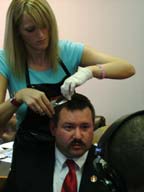The Ultimate Bad Hair Day
Got mercury? Find out by testing your hair.
by JOHN BYRNE BARRY
Why did New Hampshire state legislators interrupt debate recently to get haircuts? For the same reason you might want to part with a couple of inches of hair—to test for mercury contamination.
| A Quick Snip: New Hampshire legislator Robert Wiley sits down for his mercury test. |
|
 Getting tested is especially important for women of childbearing age who eat fish, says the Sierra Club’s Christina Kreitzer, who’s organizing mercury tests across the country. One in six such women in the United States has mercury levels in her blood high enough to put her baby at risk. “That translates to 630,000 infants born every year with unsafe mercury levels,” she says.
Getting tested is especially important for women of childbearing age who eat fish, says the Sierra Club’s Christina Kreitzer, who’s organizing mercury tests across the country. One in six such women in the United States has mercury levels in her blood high enough to put her baby at risk. “That translates to 630,000 infants born every year with unsafe mercury levels,” she says.
Hair test kits are available for $25. Participants are provided with instructions on how to snip half a gram of hair—about the size of a golf tee—and answer a few questions about their fish consumption, the primary way most Americans are exposed to mercury.
Fish are the “carrier” for mercury— when coal is burned in power plants, it releases mercury into the atmosphere. When it rains, the mercury finds its way into small f
ish, which are eaten by big fish and then by humans. In 2003, 45 states and territories in North America had fish advisories for local waterways.
The tests, sponsored by the Sierra Club and Greenpeace, are part of a nationwide clinical study by Drs. Steven Patch and Richard Maas, from the Environmental Quality Institute at the University of North Carolina-Asheville, who plan to test 10,000 samples. Preliminary results show a direct relationship between subjects’ mercury levels and how often they eat fish.
Dr. Patch says that mercury levels can be tested through hair, nails, and blood. Each has its own concentration, he says, but a high concentration in one translates into a high concentration in the others. The hair and nails are ways the body tries to rid itself of mercury. “But not so much that you need to send your shorn hair to a Superfund site,” he adds.
The problem is that the mercury hangs around and accumulates in tissue. However, Patch says that evidence suggests that if you cut your consumption of large predator fish (like tuna or mackerel), you can reduce your levels in a few months.
Though the risks are highest for women and children, men with high levels of mercury have an increased risk of acute coronary events and cardiovascular death. Eating fish high in mercury has also been found to put middle-aged men at a greater risk for coronary heart disease and may offset the protective effects of omega-3 fatty acids in some seafood.
Cathy Corkery, who organized the hair-testing event in New Hampshire, says the state Senate recently passed a bill that would cut smokestack emissions from coal-fired power plants, the primary source of mercury. Her message to the legislators whose hair tests come back with high levels of mercury is simple: “Reduce your consumption of fish. And pass the mercury bill.”
The Sierra Club also organized testing programs in Wisconsin, Utah, and Kentucky. Meanwhile, in May, the Sierra Club, Environmental Defense, and the National Wildlife Federation sued the EPA for “refusing to set the protective emission standards for power plants that the Clean Air Act requires.” At least 13 states have already challenged the EPA’s mercury rules.
To order a testing kit and find out more about mercury, go to sierraclub.org/mercury.
 Getting tested is especially important for women of childbearing age who eat fish, says the Sierra Club’s Christina Kreitzer, who’s organizing mercury tests across the country. One in six such women in the United States has mercury levels in her blood high enough to put her baby at risk. “That translates to 630,000 infants born every year with unsafe mercury levels,” she says.
Getting tested is especially important for women of childbearing age who eat fish, says the Sierra Club’s Christina Kreitzer, who’s organizing mercury tests across the country. One in six such women in the United States has mercury levels in her blood high enough to put her baby at risk. “That translates to 630,000 infants born every year with unsafe mercury levels,” she says.